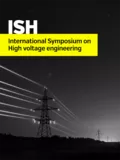Summary
The paper deals with the pollution-flashover-behaviour of partially silicone coated insulators. The 50 % pollution-flashover-voltage is determined using the “Up- and Down-Method”. By using different artificial pollution procedures, “Flow-On and Spray-Method”, a defined pollution severity of the insulators in the range between very light and heavy is adjusted. Results are evaluated in comparison to cylindrical glass insulators of the same type with overall and without silicone coating. The flashover process is evaluated with a high-speed camera. These results are used to create a resistive-layer-model for the description of the pollution flashover behaviour of insulators with hydrophobic segments. It is shown that, depending on the pollution severity and dimensioning of the silicone coating, two cases of the flashover process can be classified. Further it is revealed that a properly dimensioned partial silicone coating of insulators will lead to an exactly predictable increase of the pollution flashover voltage in comparison to a non-hydrophobic insulator. Test at salt fog conditions are carried out to evaluate the long-term hydrophobicity retention of partially coated insulators in comparison to overall coated. It is shown that there is no significant difference in hydrophobicity retention at the applied conditions.
Additional informations
| Publication type | ISH Collection |
|---|---|
| Reference | ISH2017_308 |
| Publication year | |
| Publisher | ISH |
| File size | 979 KB |
| Pages number | 6 |
| Price for non member | Free |
| Price for member | Free |



